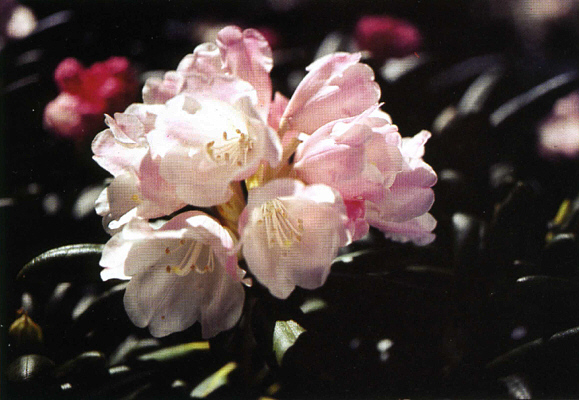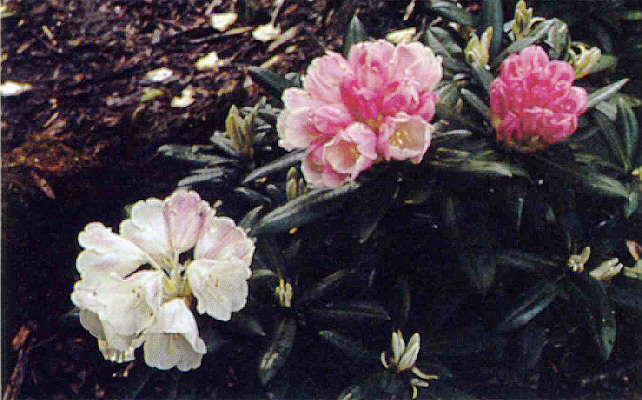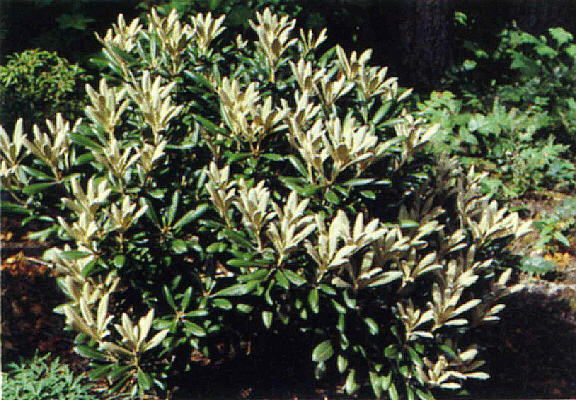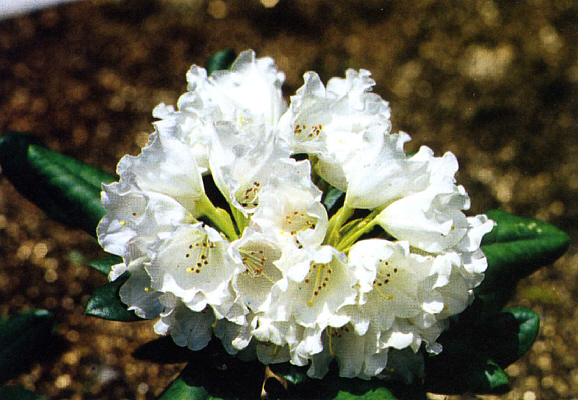Rhododendron yakushimanum
Koichiro Wada, Yokohama, Japan
Edited by Frank Doleshy

|
|
R. yakushimanum
F.C.C. 'Koichiro Wada'
Photo by Cecil Smith |
Rhododendron yakushimanum
, known outside Japan for just 50 years, was quickly accepted as one of the most beautiful rhododendrons in the world, and its popularity becomes ever greater. This species is found wild only on Yakushima, an island about 26 kilometers (16 miles) in diameter, located 60 kilometers out in the ocean from the south tip of Japan. At latitude 30° north, the coastal part of this island is subtropical enough for sugar cane and a mangrove swamp, yet the central mountains are high enough to provide a good rhododendron environment. The tallest peak, Mt. Miyanoura, reaches 1935 meters (6348 feet), but Mt. Kuromi, at 1836 meters (6024 feet) is more rocky toward the summit, making it a better rhododendron peak. These and all surrounding mountains are composed of granite, which decays to an open, porous soil favored by rhododendrons in southern Japan.
Average temperatures in the mountains are reported to be 18°C (65°F) in summer, -1.5°C (29°F) in winter. The annual rainfall of about 9 meters (354 inches) is remarkable, and fierce snowstorms have resulted in the death of winter mountain climbers.
As a result of
R. yakushimanum's
immense popularity, its name is often shortened to "Yaku rhododendron" or simply "Yaku'". Its basic features are widely known and can be summarized as follows: habit of growth may be upright but is often dense and compact, giving the plants a domed shape prized by many growers; leaves are dark green, shining, often curled down, usually with thick, woolly indumentum on the lower surface; flowers are always campanulate, i.e., bell-shaped, opening from pink buds, then becoming lighter, usually almost pure white in full bloom, but with notable color variation to be seen in the wild. Trusses may be large and dense, of nice shape, or may be loose and broad, the latter kind sometimes covering almost all the plant.
This rhododendron was first described by Dr. Nakai as
R. yakushimanum
but was later re-described as
R. metternichii
var.
yakushimanum
(Nakai) Ohwi. The first of these names remains the more popular among non botanists.

|
|
3 stages of bloom dark pink, light pink, and nearly white.
Photo by Cecil Smith |

|
| New growth with soft wooly indumentum. |

|
|
R. yakushimanum
F.C.C. 'Koichiro Wada'
Photo by Cecil Smith |
The other members of the R. metternichii group are:
- var. metternichii itself, of southwestern Japan (called in Japanese the Tsukushi-shakunage, a name sometimes most strangely Latinized);
- var. pentamerum , found in the north, more often called R. degronianum ;
- var. hondoense , of central Japan;
- The isolated east-central var. kyomaruense , of which R. metternianum is a selected form.
- Also closely affiliated is the narrow-leaved R. makinoi . Within this assemblage, the Yaku rhododendron most closely resembles R. degronianum and R. makinoi ; like these two, it usually has 5-lobed flowers.
Compared with some rhododendrons occupying a thousand times as much territory, the Yaku is more variable. Plants may be knee-high or 3 meters tall; leaves may be large or small, flat or curled, narrow or rounded, heavily indumented or barely felted; flowers may be large or small and rather narrowly or widely bell-shaped. And it is hard to identify any features that consistently go with each other.
Common sense and ordinary experience tell us we should find short, compact plants with small leaves and flowers on top of the mountains, and more open-growing ones in the forest below. But only a minority of the plants are conventional enough to follow this pattern. Large leaved specimens 2 to 3 meters tall are found on the shadowed side of the Mt. Kuromi summit block, not 20 meters down from the top, and bonsai-like plants occur on exposed rocks 500 meters below. In windy mountain passes, some plants are as compact as one would expect, while others are tall and few-leaned, as though drawn out by the wind.
To understand why these plants are not more distinctly layered by elevation, it is only necessary to consider the weather. Winds are frequent and violent enough to serve as elevators for pollen and seed, probably transporting these up or down several hundred meters during a single storm. Thus the genetic pot is continually stirred. And, although there is undoubtedly a tendency toward the development of locally adapted forms, this tendency is soon disrupted by a wind-borne shower of pollen or seed from upslope or down slope.
In the mind of an individual grower, the ideal plant may have dense clusters of big flowers (perhaps pale, perhaps more pink) on a mound of small, curved leaves. In the wild, this combination is as frequently found as many others, and the widely known F.C.C. and Exbury forms might be considered almost ideal examples. These are selections from plants the author obtained from Yaku Island in 1933 and during the next year sent to the late Lionel de Rothschild of the Exbury Garden, England. Much more swiftly than most new introductions, they became known throughout the temperate rhododendron growing areas of the entire world, and the F.C.C. was awarded in 1947. (Editor's note: The F.C.C. clone has been named 'Koichiro Wada'.)

|
|
R. yakushimanum
x
R. simiarum
Photo by K. Wada |
Since this introduction, growers in England and in the States have crossed various species and hybrids with R. yakushimanum , obtaining many new hybrids of various flower colors (pink, dark pink, yellowish white, etc.). Since R. yakushimanum itself cannot survive in the summer heat of Japan's big city areas, the author has for many years tried to bring the beauty of this species into durable, heat-tolerant hybrids. A cross with R. simiarum , another rhododendron species of utmost beauty and heat tolerance but completely forgotten in the Western rhododendron world, turned out to be quite successful; this has much more beautiful flowers than R. yakushimanum , along with exceptional ability to withstand heat and sun. It will be useful in such areas as the hot, dry part of the States and the Latin part of Europe, where R. yakushimanum itself does not survive.